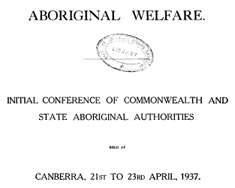Aboriginal timeline: Politics
Found 173 results for your search. Showing page 8 of 9.
1951
-
The federal government convenes the Australian Conference for Native Welfare, with all states and territories represented except Victoria and Tasmania, which claim to have no Aboriginal ‘problem’. The conference officially adopts a policy of ‘assimilation’ for Aboriginal people.
"Assimilation means, in practical terms, that it is expected that all persons of Aboriginal birth or mixed blood in Australia will live like white Australians do." [1]
1949
-
Aboriginal people are given the right to enrol and vote at federal elections provided they are entitled to enrol for state elections or have served in the armed forces.
-
The Convention on the Prevention and Punishment of the Crime of Genocide is ratified by Australia. It comes into force in 1951.
1948
-
The Commonwealth Citizenship and Nationality Act 1948 for the first time makes all Australians, including all Aboriginal people, Australian citizens. But at state level they still suffer legal discrimination.
-
The Universal Declaration of Human Rights is adopted by the newly-formed United Nations and supported by Australia.
1943
-
The NSW government passes the Aborigines Protection (Amendment) Act 1943 which in Section 18c introduces Exemption Certificates that allow certain Aboriginal people to be exempted from the restrictive legislation and entitled to similar rights as non-Aboriginal people, e.g. to vote, drink alcohol and move freely and send their children to school. In return they "shall be deemed not to be an aborigine [sic]" which means they have to give up their cultural activities and contacts to family and community. The Act remains in force until 1969.
Aboriginal people use the derogatory terms ‘dog tags’ or ‘dog licences’ to refer to the certificates. Giving up their traditional lifestyle is promoted to Aboriginal people as the only opportunity to overcome poverty, gain work and access to education and social welfare benefits.
-
A further amendment to the Aboriginal protection legislation in NSW gives two Aboriginal people – one ‘full-blood’ and one ‘half-caste’ – representation on the Aboriginal Welfare Board. Walter Page and William Ferguson, both Aboriginal Progressive Association members, take up the positions.
1941
-
The Child Endowment Act is passed but declares no endowment should be paid to dependent Aboriginal people.
1940
-
Amendments to the NSW Aborigines protection legislation results in the replacement of the Aborigines Protection Board with the NSW Aborigines Welfare Board. Responsibility for Aboriginal education is transferred to the Department for Education, which takes control of reserve buildings and starts to provide trained teachers. ‘Aboriginal’ schools provide education beyond Grade 3.
-
In the 1940s most federal social security benefits are extended to Aboriginal people.
-
White Australia policy succeeds: 99% of Australia’s 7 million people are white.
1939
-
As a result of the 1937 conference Queensland passes legislation allowing Aboriginal people to receive workers’ compensation, and the Northern Territory government sets up a Native Affairs Branch.
1938
-
150 years after European occupation the Aboriginal Progressive Association declares a Day of Mourning. It holds a conference in Sydney, a landmark meeting of Aboriginal peoples, to bring attention to the plight and imposed conditions of Aboriginal people, and campaign for full citizenship and land rights. This is the first of many Aboriginal protests against inequality, injustice, dispossession of land and protectionist policies, and is considered the start of the Aboriginal political movement.
-
The NSW government changes Aboriginal policy from ‘protection’ to assimilation following the 1937 conference.
1937
-

Aboriginal Welfare - Conference of Commonwealth and State Authorities called by the federal government, decides that the official policy for some Aboriginal people is assimilation policy. Aboriginal people of mixed descent are to be assimilated into white society whether they want to be or not, those not living tribally are to be educated and all others are to stay on reserves. The minutes of the meeting say:
“The destiny of the natives of aboriginal origin, but not of the full blood, lies in their ultimate absorption… with a view to their taking their place in the white community on an equal footing with the whites.” [2]
In practice, assimilation policies lead to the destruction of Aboriginal identity and culture, justification of dispossession and the removal of Aboriginal children.
In 50 years we should forget that there were any Aborigines in this country.
— A.O. Neville, Western Australian Chief Aboriginal Protector [3]
1936
-
Western Australia Aborigines Act is amended to permit Aboriginal people to be taken into custody without trial or appeal and to prevent them from entering prescribed towns without a permit.
1933
-
Yorta Yorta man William Cooper establishes the Australian Aborigines' League in Melbourne together with Margaret Tucker, Eric Onus, Anna and Caleb Morgan, and Shadrach James. Cooper is secretary of the League which campaigns for the repeal of discriminatory legislation and First Nations representation in the Australian Parliament.
1922
-
Regulations in the Northern Territory exclude Aboriginal people from voting. Officials have the power to decide who is Aboriginal.
1918
-
The Northern Territory Aboriginal Ordinance Act "ensured that Aboriginal people could not drink or possess or supply alcohol or methylated spirits, could not come within two chains of licensed premises, have firearms, marry non-Aboriginal people without permission or have sex across the colour line". [4] The Ordinance also forbids mining on Aboriginal Reserve Land.
1912
-
Maternity allowance is introduced but does not include Aboriginal people.
References
View article sources (4)
[1]
'Timeline of legislation affecting Aboriginal people', DECS Curriculum Services, www.aboriginaleducation.sa.edu.au
[2]
National Library of Australia, nla.gov.au/nla.aus-vn118931
[3]
'Governments are attempting to steal our original sovereign citizenship and independence', First Nations Interim National Unity Government 16/6/2013
[4]
dreamtime.net.au/indigenous/timeline3.cfm
